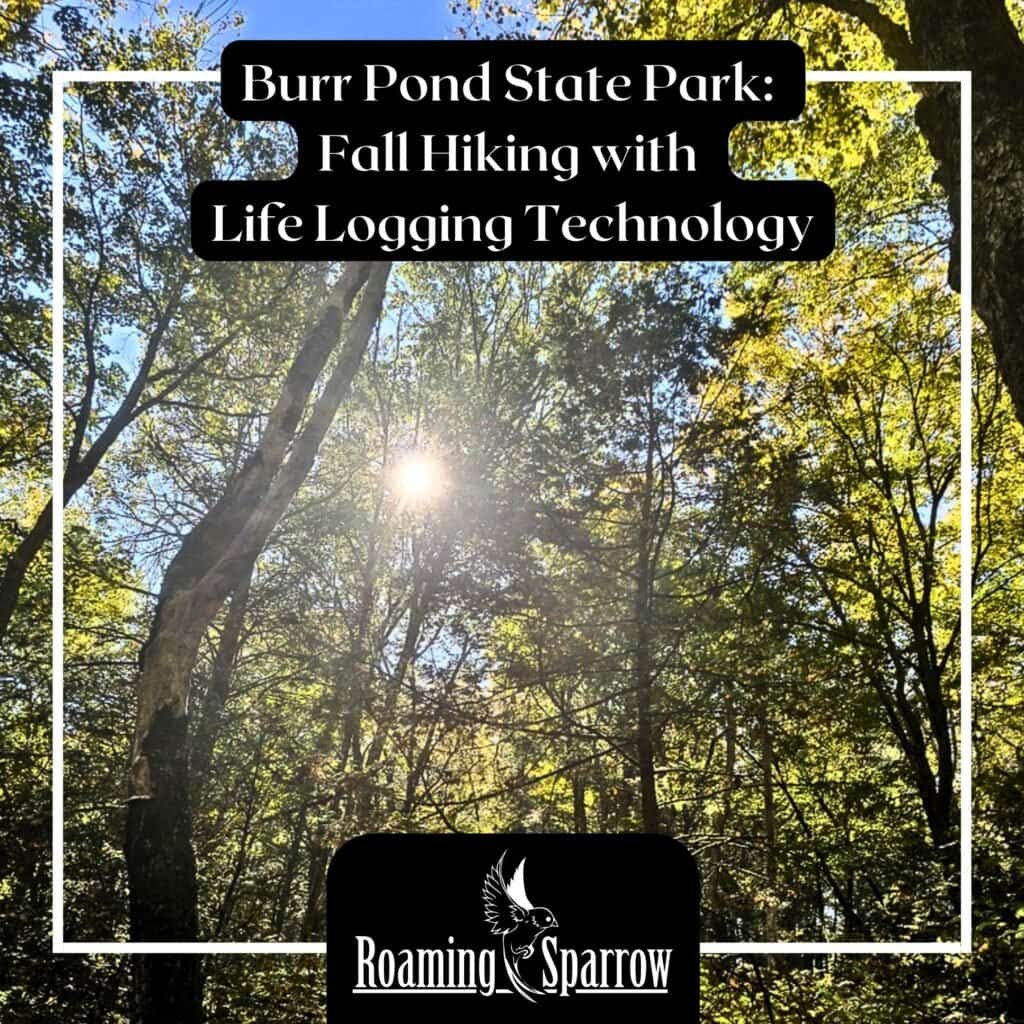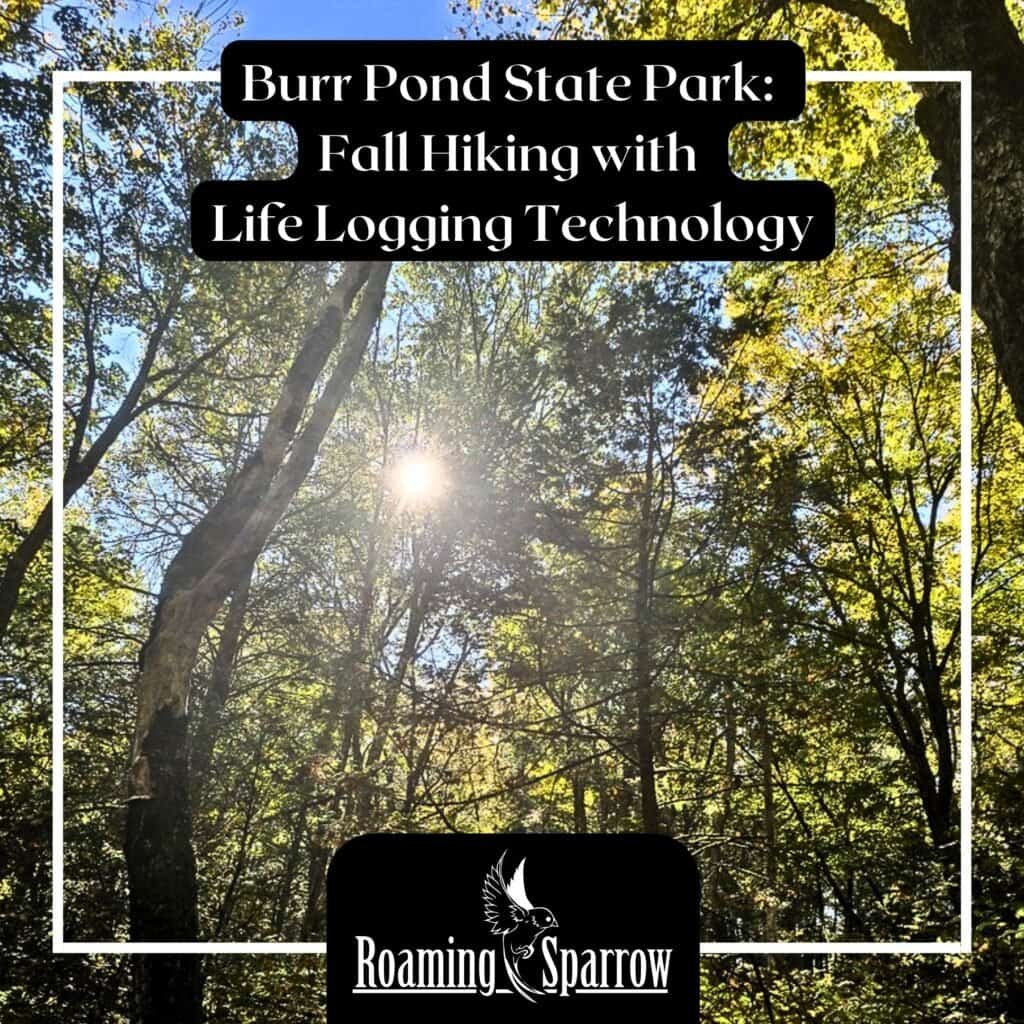

Another trip around Burr Pond State Park, and like they say—you can never step into the same river twice. The water keeps moving, the seasons shift, and every visit reveals something new. This time? Perfect fall conditions. Leaves drifting down, blue skies overhead, unseasonably warm but still comfortable. Just another afternoon hiking with my sister, but captured through a completely different lens.
I’ve hiked this trail multiple times. Once when the pond was frozen solid. Another time battling clouds of gnats. A breezy spring day that made the water dance. Each visit writes its own story, and today’s chapter involved testing out a life logging device—a small camera that automatically snaps photos every three minutes.

Why Life Logging for Hiking?
I’ve got a trip to Portugal coming up to tackle the Fisherman’s Trail, and I wanted to experiment with different ways to capture the experience. The concept behind life logging intrigues me: instead of consciously deciding when to photograph, the device just works in the background, documenting moments I might otherwise miss.
The trade-off? Photo quality. You can definitely tell which shots came from my phone versus the life logging device. But that’s not really the point. With the camera firing every three minutes, it captures a wider perspective of the day—those in-between moments when you’re just walking, breathing, taking it all in. Sometimes the best memories aren’t the ones we consciously choose to photograph.


The Burr Pond State Park Experience
Burr Pond State Park sits at 385 Burr Mountain Rd in Torrington, Connecticut, offering one of the area’s more accessible hiking loops. The trail circles the pond, providing consistent water views without demanding technical skills or extreme elevation changes. It’s the kind of hike that lets you focus on your surroundings rather than your footing.

This loop has become a regular destination for my sister and me. Not because it’s particularly challenging or remote, but because it delivers. Every season transforms the experience. Today’s fall conditions highlighted why Connecticut hiking deserves more attention—the foliage was starting its color shift, leaves carpeted the trail, and the late afternoon light filtered through the canopy in that golden way that only happens a few weeks each year.
The unseasonable warmth made for comfortable hiking temperatures without the summer humidity that can make Connecticut trails feel oppressive. Fall hiking in this region hits differently when you catch it at the right moment, and today was that moment.

Life Logging Technology: The Experiment Continues
Testing the life logging device revealed both strengths and limitations. The automated three-minute intervals meant I ended up with hundreds of photos, most capturing mundane trail sections or my hiking boots. But scattered throughout were genuine moments—candid shots of my sister laughing, unexpected trail perspectives, and those transitional moments between destinations that usually go undocumented.
Traditional photography requires intention. You see something worth capturing, pull out your phone, frame the shot, and click. Life logging removes that decision-making process entirely. The camera doesn’t care if the view is spectacular or ordinary—it just documents the progression of time and movement.
For the upcoming Portugal hike along the Fisherman’s Trail, I’m planning to run both the life logging device and my phone camera. The phone will capture the intentional shots—dramatic coastal views, architectural details, moments worth sharing. The life logger will fill in the gaps, creating a more complete timeline of the experience.

Connecticut Hiking: Underrated and Accessible
Burr Pond State Park represents what makes Connecticut hiking appealing for both locals and visitors. You don’t need to drive hours into remote wilderness to find quality trail experiences. This loop sits less than an hour from Hartford, making it perfect for afternoon adventures without requiring a full day commitment.
Connecticut state parks offer consistent maintenance and clear trail marking, which matters more than hikers sometimes acknowledge. When you’re testing new gear or just want a reliable outdoor experience, knowing the trail won’t suddenly disappear or become unsafe provides peace of mind.
The pond itself serves as the trail’s anchor point. Water views break up the forested sections, creating natural stopping points for photos, rest breaks, or just watching the surface ripple. On calm days, the reflections can be stunning. On windy days, the water provides movement and sound. Either way, having water as a constant companion changes the hiking dynamic compared to purely forested trails.

Visual Documentation: Phone vs Life Logger
Reviewing the day’s photos made the quality difference obvious. My phone camera captured sharp details, proper color balance, and well-composed shots. The life logging device delivered grainier images, occasional motion blur, and random framing since it shoots automatically regardless of what’s happening.
But here’s what surprised me: some of the life logger’s “imperfect” shots told better stories. A blurred image of leaves falling captured the movement in a way a crisp photo couldn’t. An awkwardly framed shot of the trail ahead showed exactly what hiking feels like in that moment—not a carefully composed landscape, but the actual view while putting one foot in front of the other.
For travel documentation, especially multi-day hikes, this combination approach makes sense. Use the phone for intentional photography—the shots you want to share, the moments worth preserving in high quality. Let the life logger run continuously, building a visual timeline that fills the narrative gaps between those highlight moments.
The Video Component
I also captured video footage during the hike, which you can check out here. Video adds another layer to trail documentation, capturing movement, sound, and the lived experience in ways photos can’t quite match.
Combining video, traditional photography, and life logging creates a comprehensive documentation system. Each medium serves a different purpose. Video shows the experience in motion. Phone photos preserve quality imagery of specific moments. Life logging builds the connecting tissue between everything else.
For the Portugal trip, I’m considering how to balance all three without spending the entire hike fiddling with devices. The goal is documentation, not distraction. The life logger helps with this—set it and forget it, letting it work in the background while focusing on the actual experience.

Fall Hiking Conditions in Connecticut
Today’s conditions reminded me why fall ranks as the premium hiking season in this region. Summer brings heat and bugs. Winter can make trails icy and challenging. Spring means mud season and unpredictable weather. But fall delivers.
The temperature was comfortable enough for continuous movement without overheating, but cool enough to keep things pleasant. The changing foliage added visual interest without requiring us to time our visit for peak colors. Even slightly past prime, the fall palette transforms familiar trails into something worth experiencing again.
Connecticut’s deciduous forests create dramatic seasonal shifts. Burr Pond State Park demonstrates this perfectly—the same trail that feels green and enclosed in summer opens up in fall as leaves drop, revealing new sight lines and perspectives. The pond becomes more visible through the trees, and distant hills that summer foliage obscures suddenly appear.

Preparing for the Fisherman’s Trail
This Burr Pond State Park hike served as both recreation and research. The Fisherman’s Trail in Portugal will demand different considerations—longer daily distances, coastal exposure, navigation in unfamiliar territory, and sustained multi-day hiking. But testing documentation systems on familiar local trails makes sense before taking them international.
The life logging device will prove particularly useful on multi-day hikes. When you’re covering serious distance, stopping frequently for photos disrupts rhythm and burns daylight. Having a camera that automatically documents the journey means fewer interruptions while still preserving a visual record of the experience.
Portugal’s coastal scenery will obviously differ from Connecticut forests, but the documentation principles remain constant. Capture the intentional moments. Let technology fill the gaps. Focus on the experience rather than the equipment.

The Value of Familiar Trails
Returning to the same trail multiple times might seem repetitive, but Burr Pond State Park proves otherwise. Frozen pond. Gnat clouds. Breezy spring day. Perfect fall afternoon. Each visit writes its own story while the fundamental trail remains constant.
Familiar trails serve as baselines. You know the distance, the difficulty, the general conditions. This familiarity lets you focus on variables—seasonal changes, new equipment testing, different companions, or just your own mental state on that particular day.
For hikers who chase new destinations constantly, there’s value in occasionally returning to known trails. You notice things you missed before. You measure your own changes against a stable environment. You build deeper connection with a specific place rather than superficial experience with many places.
Looking Ahead
The upcoming Portugal trip represents a significant step up from afternoon Connecticut hikes. Multi-day coastal hiking demands different preparation, different gear, and different mindset. But these local trail sessions build the foundation—testing equipment, maintaining conditioning, and remembering why hiking matters in the first place.
Burr Pond State Park won’t make anyone’s bucket list of world-class hiking destinations. It doesn’t need to. It delivers accessible, reliable outdoor experience close to home, which matters more than spectacular views in remote locations for most people’s actual hiking frequency.
The life logging experiment continues. The fall hiking season rolls on. Portugal approaches. And familiar trails keep offering new perspectives, one automated photo every three minutes.
Recent Work & Publications

The Last Train: 46 Days with the Final Ringling Brothers Circus
Available on Amazon
In April 2017, I left my Atlanta circus company to join the final tour of Ringling Brothers and Barnum & Bailey Circus—”The Greatest Show on Earth” closing after 146 years.
The Last Train captures the last 46 days of an American institution from inside the legendary mile-long circus train. Experience the brutal 12-hour setups, the international community of 300 performers from over 30 countries, and the bittersweet reality of giving everything to something that’s ending.
From lion encounters during load-out to watching America roll by from train vestibules, from emergency breakdowns to the emotional final bow at Nassau Veterans Memorial Coliseum on May 21, 2017—this memoir preserves how the world’s most famous circus actually worked, and what it meant to the people who lived it.
Paperback – August 23, 2025

The Secret to 7-Figure Living: How to Open Your Life to Boundless Joy, Prosperity, and Freedom
Available on Amazon
This book redefines prosperity and success beyond superficial wealth, instead measured by intentional cultivation of creativity, adventure, strong relationships, and purpose.
Key concepts include:
- Prioritizing life experiences over material accumulation
- Embracing minimalism to create space for deeper connections
- Generous living with time, skills, and focus
- Choosing quality relationships over quantity
- Designing environments that spark inspiration
- Aligning actions with values-based goals
- Leaving meaningful legacy through everyday choices
The book provides a blueprint for cultivating happiness accessible to everyone willing to redefine affluence on their own terms, regardless of financial constraints.
Paperback – February 12, 2024
Please visit:
Our Sponsor
